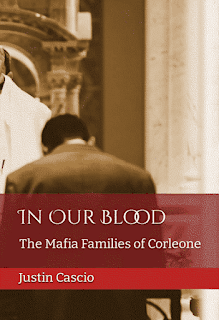On this date in 1986...
 |
Michael and Anthony Spilotro
|
Brothers Anthony "the Ant" Spilotro, forty-eight, and Michael Spilotro, forty-one, were murdered by underworld colleagues in the basement of a Bensenville, Illinois, home on Saturday, June 14, 1986. The brothers' remains were discovered buried in an Indiana cornfield nine days later.
Nicholas Calabrese, an Outfit member who later turned informant, told authorities that the Spilotros were called to a June 14 mid-afternoon meeting with Chicago bosses. The brothers left Michael's Oak Park, Illinois, townhouse (1102 S. Maple Avenue) at about two o'clock and traveled in Michael's 1986 Lincoln Continental to their appointment. Reports indicate they were met by James Marcello, who brought them to the basement in Bensenville, a suburban DuPage County village adjacent to O'Hare International Airport.
The pretext for the meeting reportedly was the promotion of Michael Spilotro from Outfit associate to full member. The brothers had schemed against Outfit bosses and were apprehensive about the meeting. Michael told his wife if he wasn't back home by nine o'clock that night, "it was no good." But they went to their appointment unarmed.
 |
Nicholas Calabrese
|
When the brothers arrived, they were attacked by Nicholas Calabrese and other mobsters. Years later, Calabrese recalled that James LaPietra, John Fecarotta, John "No Nose" DiFronzo, Sam "Wings" Carlisi, Louie "the Mooch" Eboli, James Marcello, Louis Marino, Joseph Ferriola and Ernest "Rocky" Infelise were present at that time. Calabrese asserted that he tackled Michael Spilotro and held his legs, while others beat and strangled him. Anthony Spilotro made a last request: for a moment to say a prayer. No one responded to his plea, and he was mercilessly beaten until he was dead.
Fecarotta and others were responsible for disposing of the brothers' remains. They drove the bodies about seventy-five miles southeast of Bensenville (sixty miles south of Chicago) to the outskirts of Enos, in Newton County, Indiana. There, the brothers' bodies, stripped down to their underwear, were buried on top of each other in a shallow grave in a recently planted corn field.
When Michael did not return home that night, his wife called police to report him missing. On the sixteenth, the Lincoln Continental was located at a Schiller Park motel near O'Hare. There was no indication that any struggle or violence had occurred within the car, and its doors were found locked. The next day, federal agents joined the search, as a fugitive arrest warrant was issued by a U.S. magistrate in Las Vegas for Anthony Spilotro. "The Ant" had been due to appear in a Las Vegas court on the seventeenth in preparation for a retrial on a burglary ring case.
Farmer Michael Kinz discovered a patch of freshly turned earth within his corn field at the Willow Slough wildlife preserve on June 23. He first thought that a poacher had covered up the carcass of a deer killed out of season. Kinz contacted Dick Hudson of the Indiana Division of Fish and Wildlife, and they began digging. They discovered the human remains about three feet down. The Newton County Sheriff's Department was summoned.
Law enforcement reportedly identified the bodies using dental records. Autopsies on June 24 revealed that the Spilotros died of blunt force trauma to head, neck and chest, which the medical examiner attributed to punches and kicks, and asphyxiation due to hemorrhage. (The listing of asphyxiation as a cause of death prompted some in the news media to incorrectly conclude that the brothers had been buried alive. The medical examiner could not precisely relate the time of death to the time of burial but noted that asphyxiation was caused by the lungs filling with blood.) Toxicology reports indicated that they had consumed alcohol shortly before their deaths, giving rise to the speculation that they may have had drinks with the men who killed them.
On June 26, the Roman Catholic Archdiocese of Chicago determined that the brothers should be denied church funeral services. That decision was made after the Rev. Thomas Paprocki, vice chancellor of the archdiocese, reviewed criminal information supplied by an undisclosed source. Father Paprocki indicated that the church refused to grant funerals to crime figures in order to avoid public scandal. But the denial itself turned into a scandal, as many in Chicago protested it and called attention to the church's willingness in the past to accept large financial contributions from Michael Spilotro. (Father Paprocki argued that cash contributions from known crime figures were sometimes rejected by the church and that donations generally did not result in public scandal as they were made privately.)
A service was conducted the next morning at the non-denominational Salerno Galewood Chapel funeral home on North Harlem Avenue. Numerous floral offerings filled the chapel and surrounded the two bronze coffins. The Rev. John Fearon of St. Bernardine's Roman Catholic Church in Forest Park, of which Michael was a member, delivered a homily. About 300 people attended the service. The chapel was closed to the press, but observers noted the presence of Anthony Spilotro's Vegas lieutenant Herbert Blitzstein and actor Robert Conrad. Following the service, the Spilotro brothers were buried at Queen of Heaven Cemetery in Hillside, Illinois.
Background
The motives for the Spilotro murders were fairly well understood in 1986 and became more clear with the passage of time. As soon as their bodies were found, former FBI Special Agent William Roemer told the press, "[Anthony] Spilotro wasn't doing his job in Las Vegas. He maintained too high a profile there... He was under the glare of the harshest spotlight."
 |
Anthony Spilotro
|
Anthony Spilotro, a "made" member of the Chicago Outfit since 1963, mismanaged Outfit affairs in Las Vegas and drew excessive attention upon himself, while attempting to enhance his own wealth and power. Rather than focus on quietly maintaining order and ensuring a lucrative and smoothly run skim operation, Spilotro insisted on engaging in more conventional and order-threatening rackets, such as extortion, burglary, loan sharking. His obvious criminal activity got him banned from Vegas casinos. His violent tendencies - he was linked with a number of murders but never convicted - caused some of his Vegas underlings, including Frank Cullotta, to seek protection from federal agents and become witnesses against Spilotro and Chicago underworld bosses. Outfit leader Joseph "Doves" Aiuppa was convicted and sentenced to prison in connection with skim operations, in large part because of scrutiny triggered by Spilotro. Reportedly, "the Ant's" fate was sealed when Aiuppa learned that Spilotro was having an affair with the wife of Frank "Lefty" Rosenthal.
An accomplished and innovative gambler, Rosenthal was responsible for managing Outfit investments in the Stardust and other Las Vegas casinos and maximizing the underworld's illegal "skim" siphoned off pretax casino income. Spilotro endangered important underworld relationships through the affair with Rosenthal's wife, and reportedly went so far as to plot the murder of Rosenthal himself. (Rosenthal also became a government informant, though his role, hidden by the codename "Achilles," was not exposed until after his 2008 death.) Spilotro and Rosenthal had been close friends in Chicago - "Lefty" reportedly once talked Fiore "Fifi" Buccieri out of murdering Spilotro - but their relationship quickly soured after their early 1970s arrival in Las Vegas.
In the 1980s, Spilotro became a favorite target for prosecutors. He faced charges of directing a burglary ring in 1980-1981. Prosecutions relating to his "Hole in the Wall Gang" continued for years. He was due to be retried on the matter in Nevada on the same day his body was discovered in the corn field. A 1986 prosecution for racketeering ended in an April 8, 1986, mistrial, but more charges loomed. He faced federal trial in Kansas City, Missouri, in connection with casino skimming operations and another federal case in Las Vegas, relating to the 1979 murder of a police informant. Before the end of April, a federal grand jury in Chicago indicted Michael Spilotro, owner of Hoagies restaurant in Chicago, for extortion.
 |
Anthony Spilotro
|
'Family Secrets'
Outfit bosses were brought to trial for the Spilotro killings and many other offenses in the "Family Secrets" case of 2007, which resulted in plea deals and guilty verdicts. Turncoat Nicholas Calabrese testified for five days. While Calabrese listed the mobsters present at the time of the Spilotros' murders, he could not say who specifically was responsible for the fatal beatings given to the brothers. He testified that he, with help from Louie Eboli, was holding down Michael Spilotro and had his back toward Anthony Spilotro.
Though the Calabrese account of the killings included John "No Nose" DiFronzo, DiFronzo was not charged in the case.
Five of the original fourteen Family Secrets defendants remained at the close of the trial. The others had been removed through plea deals. After the ten-week trial, jurors deliberated for four days before finding the defendants - Frank "the Breeze" Calabrese, Sr. (brother of government witness Nicholas Calabrese), Joseph "Joey the Clown" Lombardo, James Marcello, Paul "the Indian" Schiro and Anthony "Twan" Doyle - guilty on all counts on September 10, 2007.
The jury separately considered the issue of whether Marcello, Frank Calabrese, Lombardo and Schiro used murder to advance the interests of their criminal conspiracy. Eighteen murders and one attempted murder had been charged against the defendants. On September 27, the jury reported that Marcello, Calabrese and Lombardo were guilty of racketeering murders. (The panel deadlocked on the charge against Schiro.) Marcello specifically was convicted of participating in the killings of the Spilotro brothers, as well as in the 1981 beating death of Nicholas D'Andrea.
Government witness Nicholas Calabrese was sentenced March 26, 2009, to serve a term of twelve years and four months in prison. He admitted involvement in a number of mob murders, including the killing of the Spilotro brothers.
Sources:
- "14 defendants indicted for alleged organized crime activities...," press release of the United States Attorney for the Northern District of Illinois, U.S. Department of Justice, April 25, 2005.
- Anthony Spilotro Certificate of Death, Indiana State Board of Health, signed by coroner on July 25, 1985.
- Cawley, Janet, "Spilotro a 'nice boy' who grew up tough," Chicago Tribune, March 13, 1983, p. B1.
- Chicago Tribune, "Did reputed mob brothers run or were they killed?" Elyria OH Chronicle-Telegram, June 19, 1986, p. B2.
- Dwyer, Bill, "Details of Spilotro murders revealed in mob trial," Oak Park Journal, oakpark.com, Aug. 14, 2007, updated Feb. 11, 2021.
- Goudie, Chuck, "The last family secret: 30 years after the Spilotro hit," ABC-7 Chicago, abc7chicago.com, June 24, 2016.
- Hidlay, William C., "Mourners weep at funeral for Spilotro brothers," Associated Press (AP), apnews.com, June 27, 1986.
- Houston, Jack, "Secrets led to Spilotro rites denial," Chicago Tribune, June 27, 1986.
- Hunt, Thomas, "Family Secrets" coverage, Mob-News, mob-news.blogspot.com, 2007-2009.
- Hunt, Thomas, "Outfit boss DiFronzo fought the law, and the law lost," The American Mafia, mafiahistory.us, 2018-2021.
- Koziol, Ronald, and Edward Baumann, "Spilotros found beaten to death," Chicago Tribune, June 25, 1986.
- Koziol, Ronald, and John O'Brien," "Spilotros may have had drinks with killers," Chicago Tribune, July 25, 1986.
- Manning, Mary, "Frank 'Lefty' Rosenthal dies at age 79," Las Vegas Sun, lasvegassun.com, Oct. 14, 2008.
- Michael Spilotro Certificate of Death, Indiana State Board of Health, signed by coroner on July 25, 1985.
- Schumacker, Geoff, "Tony Spilotro's last act," Nevada Public Radio Desert Companion, May 23, 2016.
- Valin, Edmond, "'Lefty' Rosenthal was high-level FBI source into activities of Chicago Outfit," The American Mafia, mafiahistory.us, 2018.
































